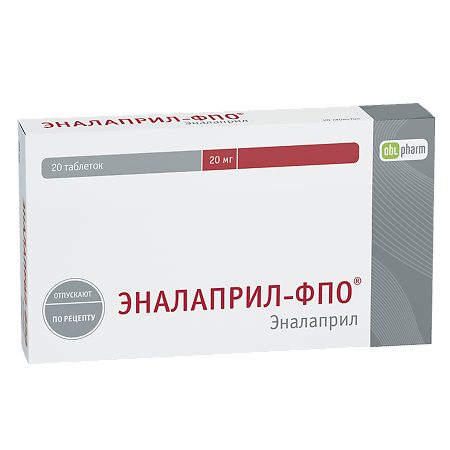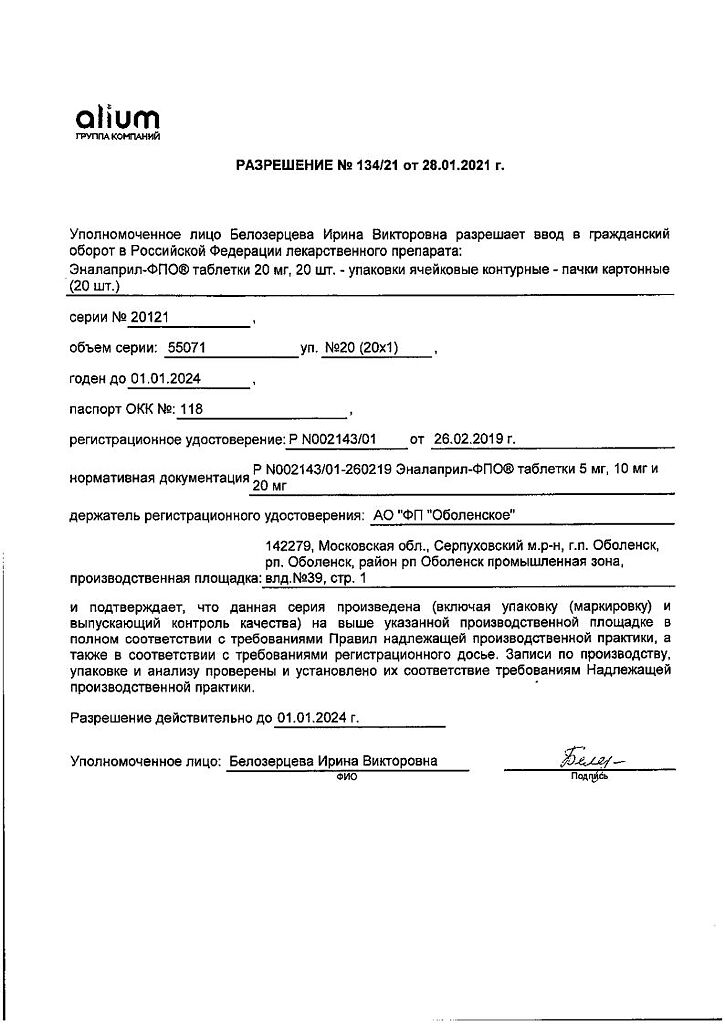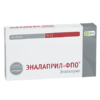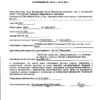No products in the cart.
Enalapril-FPO, 20 mg tablets 20 pcs
€2.16 €1.96
Description
Heart failure, Edema, Hypertension (high blood pressure)
Arterial hypertension (patients who are indicated for combination therapy).
Indications
Indications
Arterial hypertension (patients for whom combination therapy is indicated).
Pharmacological effect
Pharmacological effect
Antihypertensive combined drug (ACE blocker + diuretic)
Special instructions
Special instructions
Arterial hypotension with all clinical consequences can be observed after the first dose of Enalapril-N tablets in patients with severe CHF and hyponatremia, severe renal failure or left ventricular dysfunction and, in particular, in patients with hypovolemia as a result of diuretic therapy, salt-free diet, diarrhea, vomiting or hemodialysis.
If arterial hypotension occurs, it is necessary to place the patient on his back with a low head and, if necessary, adjust the volume of blood volume by infusion of 0.9% sodium chloride solution. Arterial hypotension that occurs after taking the first dose is not a contraindication for further treatment.
Caution is required in patients with coronary artery disease, severe cerebrovascular diseases, aortic stenosis or idiopathic hypertrophic obstructive subaortic stenosis, obstructing the outflow of blood from the left ventricle, severe atherosclerosis, in elderly patients as a result of the risk of developing arterial hypotension and deterioration of blood supply to the heart, brain and kidneys.
Regular monitoring of serum electrolyte concentrations during treatment is necessary to identify possible imbalances and promptly take the necessary measures. Determination of serum electrolyte concentrations is mandatory for patients with prolonged diarrhea and vomiting.
In patients taking the drug Enalapril N, it is necessary to identify signs of water-electrolyte imbalance, such as dryness of the oral mucosa, thirst, weakness, drowsiness, increased excitability, myalgia and cramps (mainly of the calf muscles), decreased blood pressure, tachycardia, oliguria and gastrointestinal disorders (nausea, vomiting).
The drug Enalapril N in patients with renal failure (creatinine clearance 30-75 ml/min) should be used only after preliminary titration of the doses of enalapril and hydrochlorothiazide separately, according to the doses in the combined drug Enalapril N.
Enalapril N should be used with caution in patients with liver failure or progressive liver disease, because hydrochlorothiazide can cause hepatic coma even with minimal disturbances in water and electrolyte balance. Several cases of acute liver failure with cholestatic jaundice, fulminant liver necrosis and death (rarely) have been reported during treatment with ACE inhibitors. If jaundice occurs and the activity of liver transaminases increases, treatment with Enalapril N should be stopped immediately and patients should be monitored.
Caution is necessary in all patients receiving treatment with oral hypoglycemic agents or insulin, because hydrochlorothiazide may weaken and enalapril may enhance their effect.
Thiazide diuretics may reduce renal excretion of calcium and cause a slight and transient increase in serum calcium.
Severe hypercalcemia may be a sign of hidden hyperparathyroidism. Before testing the function of the parathyroid glands, thiazide diuretics must be discontinued.
During treatment with thiazide diuretics, the concentrations of cholesterol and triglycerides in the blood serum may increase.
Therapy with thiazide diuretics may worsen hyperuricemia and/or aggravate gout in some patients. However, enalapril increases the excretion of uric acid by the kidneys, thereby counteracting the hyperuricemic effect of hydrochlorothiazide.
If angioedema of the face occurs, it is usually sufficient to discontinue therapy and prescribe antihistamines to the patient.
Angioedema of the tongue, pharynx or larynx can be fatal. In case of angioedema of the tongue, pharynx or larynx, which can lead to airway obstruction, it is necessary to immediately administer epinephrine (0.3-0.5 ml of epinephrine (adrenaline) solution subcutaneously in a ratio of 1:1000) and maintain airway patency (intubation or tracheostomy).
Among black patients receiving ACE inhibitor therapy, the incidence of angioedema is higher than among patients of other races.
Patients with a history of angioedema not associated with ACE inhibitors are at increased risk of developing angioedema when taking any ACE inhibitor.
In patients taking thiazide diuretics, hypersensitivity reactions can develop both with and without a history of allergic reactions. Worsening of systemic lupus erythematosus has been reported.
Due to the increased risk of anaphylactic reactions, Enalapril N should not be prescribed to patients undergoing hemodialysis using high-flow polyacrylonitrile membranes (AN 69®), undergoing LDL apheresis using dextran sulfate and immediately before the desensitization procedure with an allergen from Hymenoptera venom.
Before surgery (including dentistry), it is necessary to warn the anesthesiologist about the use of ACE inhibitors. During surgery or general anesthesia with the use of drugs that cause arterial hypotension, ACE inhibitors may block the formation of angiotensin II in response to compensatory release of renin. If a pronounced decrease in blood pressure develops, explained by a similar mechanism, it can be corrected by increasing the volume of blood volume.
Cough has been reported when using ACE inhibitors. The cough is dry and prolonged, which disappears after stopping taking ACE inhibitors. When making a differential diagnosis of cough, cough caused by the use of ACE inhibitors must also be taken into account.
The drug may cause a positive result in anti-doping tests.
Impact on the ability to drive vehicles and operate machinery
At the beginning of treatment with Enalapril N, a pronounced decrease in blood pressure, dizziness and drowsiness may occur, which can reduce the ability to drive vehicles and engage in other potentially hazardous activities that require increased concentration and speed of psychomotor reactions. Therefore, at the beginning of treatment, it is not recommended to drive vehicles or engage in other potentially hazardous activities that require increased concentration and speed of psychomotor reactions.
Active ingredient
Active ingredient
Enalapril
Composition
Composition
1 tab. contains:
hydrochlorothiazide 12.5 mg,
enalapril maleate 20 mg
Excipients:
lactose monohydrate 18.5 mg,
potato starch 10 mg,
microcrystalline cellulose 31 mg,
povidone 2 mg,
sodium bicarbonate 2 mg,
sodium carboxymethyl starch (sodium starch glycolate) 2 mg,
talc 1 mg,
magnesium stearate 1 mg.
Contraindications
Contraindications
– hypersensitivity to the components of the drug or sulfonamide derivatives;
– anuria;
— severe renal dysfunction (creatinine clearance < 30 ml/min);
– history of angioedema associated with previous use of ACE inhibitors and sulfonamide derivatives;
– hereditary or idiopathic angioedema;
– lactose intolerance, lactase deficiency or glucose/galactose malabsorption;
– pregnancy;
– lactation period (breastfeeding);
– children and adolescents under 18 years of age (efficacy and safety have not been established).
The drug should be used with caution in the following conditions: bilateral renal artery stenosis, stenosis of the artery of a single kidney;
severe aortic and mitral stenosis or hypertrophic obstructive cardiomyopathy;
IHD and cerebrovascular diseases (including cerebrovascular insufficiency), because an excessive decrease in blood pressure can lead to the development of myocardial infarction and stroke;
chronic heart failure; severe atherosclerosis;
severe autoimmune systemic connective tissue diseases (including systemic lupus erythematosus, scleroderma);
inhibition of bone marrow hematopoiesis;
diabetes mellitus, because thiazide diuretics can reduce glucose tolerance;
hyperkalemia; condition after kidney transplantation; impaired liver and/or kidney function (creatinine clearance 30-75 ml/min);
conditions accompanied by a decrease in blood volume (as a result of diuretic therapy, with limited salt intake, diarrhea and vomiting);
primary hyperaldosteronism;
old age.
Side Effects
Side Effects
WHO classification of the incidence of side effects: very common (>1/10), common (>1/100 and 1/1000 and 1/10,000 and <1/1000), very rare (<1/10,000), frequency unknown.
From the hematopoietic system: infrequently – anemia; rarely – neutropenia, decreased hemoglobin and hematocrit, thrombocytopenia, leukopenia, agranulocytosis, suppression of bone marrow function, suppression of bone marrow function, pancytopenia, leukopenia, lymphadenopathy, autoimmune diseases.
From the endocrine system: frequency unknown – syndrome of impaired ADH secretion.
From the nervous system: often – headache, depression, fainting; uncommon: confusion, drowsiness, insomnia, nervousness, paresthesia, dizziness; rarely – sleep disturbances, paresis (due to hypokalemia).
From the side of the organ of vision: very often – visual impairment; frequency unknown – xanthopsia.
From the cardiovascular system: often – marked decrease in blood pressure (including orthostatic hypotension), chest pain, rhythm disturbances, tachycardia, angina pectoris; uncommon – myocardial infarction or stroke, palpitations; rarely – Raynaud’s syndrome; frequency unknown – necrotizing angiitis (vasculitis, cutaneous vasculitis).
From the respiratory system: very often – cough; often – shortness of breath; uncommon: rhinorrhea, sore throat, hoarseness, bronchospasm; rarely, pulmonary infiltrates, rhinitis, allergic alveolitis/eosinophilic pneumonia, respiratory distress syndrome (including pneumonitis and pulmonary edema).
From the digestive system: very often – nausea; often – diarrhea, abdominal pain, taste disturbances; uncommon – intestinal obstruction, pancreatitis, vomiting, dyspepsia, constipation, anorexia, stomach irritation, dry oral mucosa, peptic ulcer; rarely – stomatitis, aphthous ulcers, glossitis, liver failure, hepatitis (hepatocellular or hemolytic), cholestasis, fulminant liver necrosis; very rarely – intestinal angioedema.
From the skin and subcutaneous tissue: often – skin rash, angioedema of the face, limbs, lips, tongue, glottis, larynx; uncommon – increased sweating, itching, urticaria, alopecia; rarely – erythema multiforme, Stevens-Johnson syndrome, exfoliative dermatitis, toxic epidermal necrolysis, pemphigus, erythroderma, lupus-like skin reactions, exacerbation of systemic lupus erythematosus.
From the musculoskeletal system: often – muscle cramps; infrequently – arthralgia.
From the urinary system: infrequently – impaired renal function, acute renal failure, proteinuria; rarely – oliguria, interstitial nephritis.
From the reproductive system: infrequently – decreased potency; rarely – gynecomastia.
Other: very often – asthenia; often – fatigue; uncommon – muscle cramps, tinnitus, general malaise, fever; frequency unknown (for hydrochlorothiazide) – fever, weakness.
Laboratory tests: often – hyperkalemia, hypercreatininemia; uncommon – hyperuricemia, hyponatremia; rarely, increased activity of liver transaminases, hyperbilirubinemia.
When using ACE inhibitors, a symptom complex has been described, including fever, serositis, vasculitis, myalgia, myositis, arthralgia, arthritis, a positive test for antinuclear antibodies, increased SOE, eosinophilia, leukocytosis, exanthema, photosensitivity reactions or other dermatological disorders.
With the simultaneous use of ACE inhibitors and intravenous administration of sodium aurothiomalate, a symptom complex has been described, including facial flushing, nausea, vomiting and arterial hypotension.
Interaction
Interaction
The use of potassium supplements, potassium-sparing agents or preparations containing potassium, salt substitutes, especially in patients with renal failure, can lead to a significant increase in serum potassium levels. Potassium loss while taking thiazide diuretics is usually reduced by enalapril. Serum potassium levels usually remain within normal limits.
When used simultaneously with lithium preparations, the excretion of lithium slows down (increased cardiotoxic and neurotoxic effects of lithium).
Thiazide diuretics may enhance the effect of tubocurarine chloride.
Concomitant use of thiazide diuretics, opioid analgesics or phenothiazine derivatives may lead to orthostatic hypotension.
Concomitant use of other antihypertensive drugs with enalapril, incl. beta-blockers, alpha-blockers, ganglion blocking agents, methyldopa or slow calcium channel blockers may further reduce blood pressure.
Concomitant use of allopurinol, cytostatics and immunosuppressants with ACE inhibitors may increase the risk of developing leukopenia.
Concomitant use of thiazide diuretics with corticosteroids and calcitonin can lead to the development of hypokalemia.
Concomitant use of cyclosporine with ACE inhibitors may increase the risk of developing hyperkalemia. Concomitant use of hydrochlorothiazide and cyclosporine may increase the risk of developing hyperuricemia and complicate the course of gout.
Concomitant use of NSAIDs (including selective COX-2 inhibitors) may weaken the antihypertensive effect of ACE inhibitors or angiotensin II receptor antagonists. NSAIDs and ACE inhibitors have an additive effect on increasing serum potassium, which may lead to a deterioration of renal function, especially in patients with impaired renal function. This effect is reversible. NSAIDs may reduce the diuretic and antihypertensive effects of diuretics.
Antacids may reduce the bioavailability of ACE inhibitors.
Sympathomimetics may reduce the antihypertensive effect of ACE inhibitors.
Thiazide diuretics may reduce the effect of adrenergic agonists (epinephrine).
Ethanol enhances the hypotensive effect of ACE inhibitors and thiazide diuretics, which can cause orthostatic hypotension.
Epidemiological studies suggest that the simultaneous use of ACE inhibitors and hypoglycemic agents may lead to hypoglycemia. More often, hypoglycemia develops in the first weeks of therapy in patients with impaired renal function. Long-term and controlled clinical studies of enalapril do not confirm these data and do not limit the use of enalapril in patients with diabetes mellitus. However, such patients should be under regular medical supervision. The use of oral hypoglycemic agents and insulin with thiazide diuretics may require adjustment of their doses.
A single dose of cholestyramine or colestipol reduces the absorption of hydrochlorothiazide in the gastrointestinal tract by 85% and 43%, respectively.
With the simultaneous use of ACE inhibitors and gold preparations (sodium aurothiomalate) intravenously, a symptom complex has been described, including facial flushing, nausea, vomiting and arterial hypotension.
Concomitant use of ACE inhibitors and thiazide diuretics with trimethoprim increases the risk of developing hyperkalemia.
Concomitant use of ACE inhibitors and lovastatin increased the risk of developing hyperkalemia.
When used simultaneously with ACE inhibitors, they can enhance the hypotensive effect of tricyclic antidepressants, antipsychotics, and anesthetics.
Enalapril can be used simultaneously with acetylsalicylic acid (in doses up to 300 mg/day), thrombolytics, beta-blockers and nitrates.
It may be necessary to adjust the doses of medications used for gout (probenecid, sulfinpyrazone and allopurinol), because hydrochlorothiazide can increase the concentration of uric acid; Coadministration of thiazide diuretics may lead to an increased incidence of hypersensitivity reactions to allopurinol.
Anticholinergics (atropine, biperiden) can increase the bioavailability of thiazide diuretics, reducing motility and the rate of gastrointestinal emptying.
Thiazide diuretics slow down the renal excretion of cytotoxic drugs (for example, cyclophosphamide, methotrexate) and thereby enhance their myelosuppressive effect.
It is possible to develop hemolytic anemia with the combined use of hydrochlorothiazide and methyldopa.
Hypokalemia or hypomagnesemia caused by the use of thiazide diuretics may contribute to the development of arrhythmias when taking cardiac glycosides.
In case of hypovolemia caused by taking thiazide diuretics, the risk of developing acute renal failure increases when iodinated contrast agents are administered in high doses.
Simultaneous intravenous administration of amphotericin B, as well as the use of corticotropin, laxatives and hydrochlorothiazide, may increase water and electrolyte imbalance, especially hypokalemia.
Concomitant use with carbamazepine may lead to symptomatic hyponatremia.
It is necessary to use hydrochlorothiazide with caution with drugs that can cause ventricular tachycardia of the “pirouette” type, for example, some antiarrhythmic drugs, antipsychotics.
Concomitant use of thiazide diuretics with drugs containing calcium salts may result in hypercalcemia.
Overdose
Overdose
Symptoms: increased diuresis, marked decrease in blood pressure with bradycardia or other heart rhythm disturbances, convulsions, disturbances of consciousness (including coma), acute renal failure, disturbances in blood pressure and water-electrolyte balance.
Treatment: the patient is transferred to a horizontal position with raised legs.
In mild cases, gastric lavage and ingestion of activated charcoal are indicated; in more serious cases, measures aimed at stabilizing blood pressure are indicated – intravenous administration of plasma expanders, infusion of 0.9% sodium chloride solution. The patient must monitor the level of blood pressure, heart rate, respiratory rate, serum concentration of urea, creatinine, electrolytes and diuresis, if necessary, intravenous administration of angiotensin II, hemodialysis (enalaprilat excretion rate – 62 ml/min).
Manufacturer
Manufacturer
Alium JSC, Russia
Additional information
| Manufacturer | Alium JSC, Russia |
|---|---|
| Medication form | pills |
| Brand | Alium JSC |
Related products
Buy Enalapril-FPO, 20 mg tablets 20 pcs with delivery to USA, UK, Europe and over 120 other countries.




















